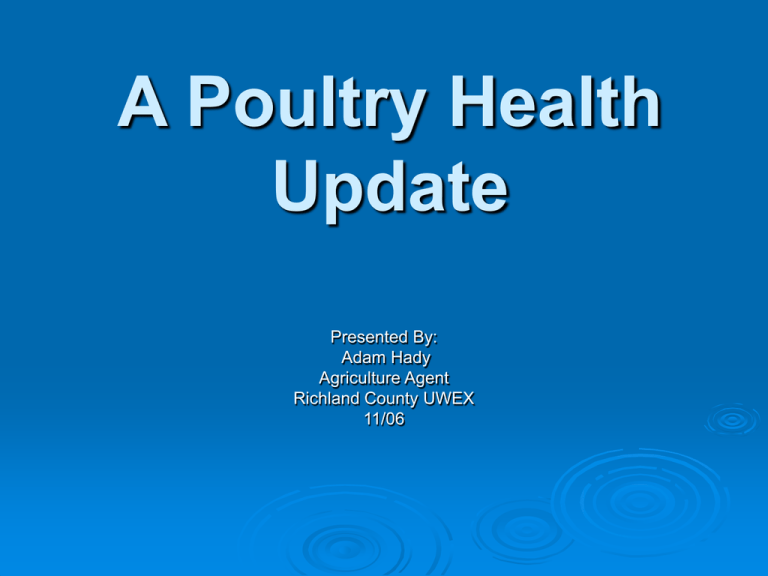A Poultry Health Update
advertisement

A Poultry Health Update Presented By: Adam Hady Agriculture Agent Richland County UWEX 11/06 Topics of the Presentation Avian Influenza Mites and Lice Respiratory Diseases Establishing a Biosecurity plan Avian Influenza What Why is it? are we so concerned? Low Path AI Mild or no clinical signs in poultry Decreased egg production Mild respiratory signs: cough, sneeze Feces, ocular, oral and nasal secretions Bird-to-bird or contaminated equipment Diagnosis: Virus isolation Serology Source: AVIAN INFLUENZA / “BIRD FLU”, High Path AI Sudden death without clinical signs Source: AVIAN INFLUENZA / “BIRD FLU”, High Path AI Decreased activity and decreased feed consumption F.A.O.- Italy Source: AVIAN INFLUENZA / “BIRD FLU”, High Path AI Decreased egg production Soft-shelled or misshapen eggs Source: AVIAN INFLUENZA / “BIRD FLU”, High Path AI Swelling of head, eyelids, comb, wattles and hocks Source: AVIAN INFLUENZA / “BIRD FLU”, High Path AI Purple discoloration (cyanosis and hemorrhage) of wattle, comb and legs Source: AVIAN INFLUENZA / “BIRD FLU”, High Path AI Nasal discharge, coughing, sneezing Lack of coordination Diarrhea F.A.O.- Italy Source: AVIAN INFLUENZA / “BIRD FLU”, Gross Lesions HPAI Vesicles and ulcers on comb Facial edema Source: AVIAN INFLUENZA / “BIRD FLU”, Gross Lesions HPAI • Hemorrhage throughout internal body organs and fat Source: AVIAN INFLUENZA / “BIRD FLU”, Gross Lesions HPAI • Hemorrhage throughout internal body organs and fat Source: AVIAN INFLUENZA / “BIRD FLU”, Other Health Concerns Mites & Lice Mites & Lice Mites Size: 1 millimeter in diameter Color: Dark Reddish Black Egg Color & Location: White to off-white along the feather shaft Mites live on the host and in the environment Mites & Lice Lice Size: 2-3 millimeters long Color: Light Brown Egg Color & Location: White and at the base of the feather Lice only live on the host, and appear to be fast moving. Mites & Lice Symptoms: Decreased Food Intake Decreased Egg Production Decreased Weight Gain Increased Susceptibility to Other Diseases If any of these symptoms are observed a visual inspection around the vent for lice or mites is recommended. Mites & Lice Treatment Sanitation and cleanliness are keys to control Chemical control: • Dust bath with Sevin® • Pyrethrin-Based spray • Ivermectin medication Respiratory Diseases These are some of the most common diseases of poultry. They cause a wide variety of impact on the flock, from production loss to mortality. Respiratory Diseases There are many causes and is very common Signs: • Coughing • Sneezing • Discharge from the eyes and nostrils Respiratory Diseases Causes: Viruses Bacteria Parasites (such as the gapeworm) High ammonia levels Respiratory Diseases Vectors: Other Chickens Rodents Manure Dust Backyard Biosecurity What is Biosecurity Measures that are taken to prevent the transfer of diseases from place to place and animal to animal. Six Steps To Biosecurity 1. Keep Your Distance 2. Keep It Clean 3. Don’t Haul Disease Home 4. Don’t Borrow Disease 5. Be Informed 6. Report Sick Birds Biosecurity Plan What A biosecurtiy plan is written document that outline procedures for preventing and handling diseases. Are is it? they practical for me? Yes, no matter what your size of operation it is worth taking time to look at how to minimize disease threats. Building a Biosecurity Plan The first step: What am I currently doing? • • • • • • • • Housing Feeders and Waterers- how are they located? What kinds of birds are commingled? What age groups of birds do I have? What are my feed sources? How do I bring new birds into the flock? How do I handle dead birds? Etc. Building a Biosecurity Plan Step Number Two: Identify the areas where diseases could be introduced Identify areas where cross contamination could occur. Building a Bio Security Plan Step Outline ways that you could prevent contamination from your list in step #2 Step Number Three Number 4 Follow your Plan References AVIAN INFLUENZA / “BIRD FLU”, PowerPoint presentation by Ron Kean , UW-Extension Poultry Specialist, 2006 “Common External Parasites in Poultry: Lice and Mites” Ohio State University Fact Sheet “Backyard Biosecurity Practices to Keep Your Birds Healthy” UDSA/ APHIS publication May 2004 American Poultry Association Website: http://www.amerpoultryassn.com/ Questions ???






